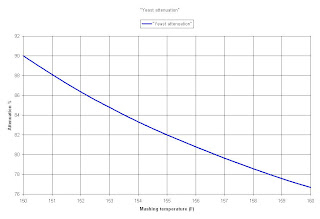Can you brew successfully that way? Yes you can, but hitting the required final gravity when you are trying to brew a specific style takes time and multiple batches until you make the needed adjustments.
So I decided to look at the behavior of one yeast strain that I use a lot, Wyeast 1056 American Ale, using empirical data recorded from several batches in order to come up with a better way when predicting the final gravity.
The analysis included all grain recipes with variable grain bills for multiple styles, from light beers up to brown ales, all using Wyeast 1056.
When looking at the graph of mashing temp against final gravity, there was a visible relationship, already known by most people.
It also shown that the suggested attenuation from the manufacture was quite off.
The graph below shows the mashing temperature in the bottom and the related attenuation on the top. The flat lines are the suggested maximum and minimum yeast attenuation. Fermentation temperatures were within the suggested range for this yeast, from 60 to 72F.

From this graph, it is clear that the higher the mashing temperature, the lower the attenuation, as expected. Based on that and using the available data points, I came up with the following function:
Attenuation%=50+800/(T-130) (for T from 150 to 160F)
where T=mashing temperature
Now, using this function, the graph below shows the predicted attenuation in red for the same batches. It would represented much better the real measured data than by just using the suggested range of 73 to 77%, which again, is way off.

It is known that many other factors affect the final gravity, but since mashing temperature seems to be an important one, using this simple function can improve the accuracy when predicting FG.
The actual graph for the function is shown below.

Another step that also help improving accuracy when estimating the FG is to exclude the dextrin sugars and other known non-fermentables from been attenuated, like carapills malt and lactose, usually added to increase head retention and body of the beer.
My basic excel calculation file do just that, by letting the user assign the estimated fermentables for each grain or adjunt.
My basic excel calculation file do just that, by letting the user assign the estimated fermentables for each grain or adjunt.
Nice work here! You get about the same as my system at 2% less attenuation for every °F about 151°F. Other data I have seen shows about 1% less attenuation per °F.
ReplyDelete